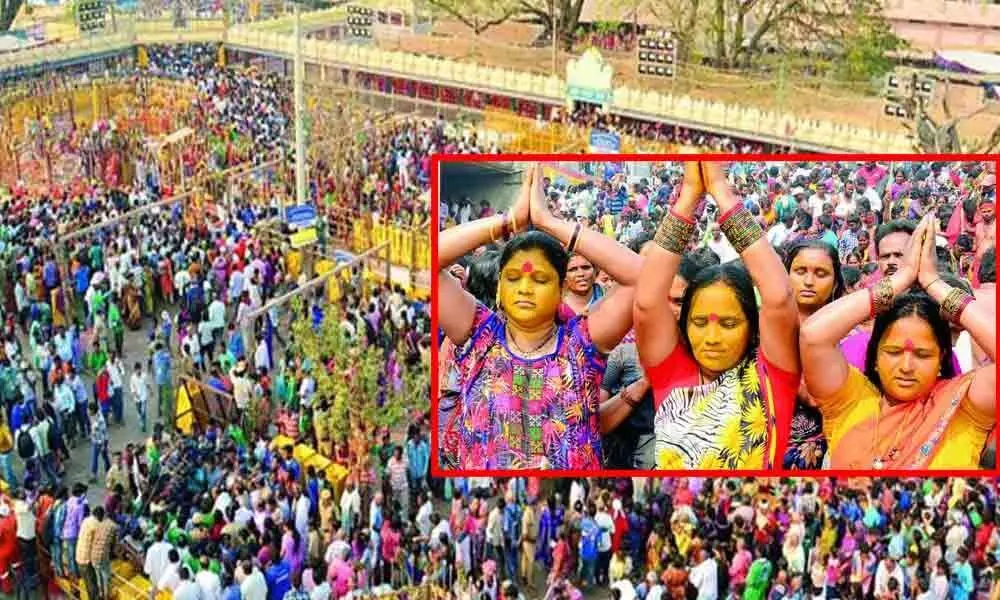Live
- SpinSci Health Tech India Pvt Ltd Announces Groundbreaking News: 1,000 New AI Jobs in Telangana
- Devotees flock to temples in Nagar Kurnool district on Vaikunta Ekadashi
- Bimal Das Gupta's introduction of acrylics to India
- Written Test for Establishment of MeeSeva Center.
- Block-Level Sports Meet Organized in Nagarkurnool
- Friendly Legal Services for Child Protection
- If You Lose Your Phone, Lodge a Complaint Immediately - SP Gaikwad.
- TikTok Star Fun Bucket Bhargav Sentenced to 20 Years for Sexual Assault
- CM Revanth Reddy Directs Measures to Resolve Tribal Issues in Telangana
- pi-labs Unveils 2024's Top 10 Victims of AI Deepfakes: From Celebrities to Power Players
Just In
Sammakka Saralamma Jatara or Medaram Jatara -2020


Sammakka Saralamma Jatara or Medaram Jatara is a tribal festival celebrated in Telangana State, India, to worship the goddesses.
Sammakka Saralamma Jatara or Medaram Jatara is a tribal festival celebrated in Telangana State, India, to worship the goddesses. It commemorates the struggle of a mother and daughter, Sammakka and Saralamma, against an unjust law by the reigning rulers. It's believed that the Medaram Jatara attracts the country's largest number of devotees after Kumbha Mela. This is the biggest people in the world meeting Jatara celebrated in Madaram, Tadvai Mandal in the district of Mulugu, held at about 100 km from Warangal city and 250 km from Hyderabad.
The Sammakka Sarakka Jatra is a State Festival of Govt. of Telangana. Many tribal Devotees from different states of India (Madya Pradesh, Chhattisgarh, Orissa, Maharastra, Karnataka and parts of Jharkhand)reach to the festive place to celebrate the Jatara.
History - Medaram Jatara
There are many stories about sammakka's miraculous powers. According to a tribal story, some tribal leaders who went for a hunt found a newborn girl (Sammakka) emitting enormous light playing among tigers about 6-7 centuries ago, that is in the 13th century. She was taken to their habitation. The head of the tribe adopted her and brought up as a chieftain (She later became the savior of the tribals of the region) she was married to Pagididda Raju a feudatory tribal chief of Kakatiyas(who ruled the country of Andhra from Warangal City between 1000 AD and 1380 AD). She was blessed with 2 daughters and one son namely Sarakka, Nagulamma and Jampanna respectively.
After some time, there was a severe drought that lasted for years and as a result, the mighty Godavari River dried up. pagedde Raju didn't pay tribute to King Pratapa Rudra. In turn king Pratapa Rudra sent his army to subdue the tribals and collect the tribute.
Then a War was fought between tribal chief pagidde Raju and Kakatiya army on the banks of "Sampenga Vagu" (Jampanna Vagu). The Koya army fought valiantly but could not withstand the well trained Kakatiya army. While Pagidda Raju has fought valiantly, his daughters Sarakka, Nagulamma, son in law Govinda Raju lost (Sarakka's husband) lives in the battle. Jampanna also died later on in Sampenga Vagu.
Sammakka also declares battle and battles after hearing this news and does much harm to the kakatiya army. Surprised by her courage and valour, the Kakatiya Prime Minister toured the war-torn Koya Kingdom with a peace offering and gave Sammakka a position as the chief queen in the emperor's harem. Samakka turned the offer down and vowed to go on battling to avenge the fallen.
The grieving Koyas searched for their queen all they found were a red ochre box(a container of vermilion), her bangles … and the pug marks of a huge full grown tigress, exactly the same place where she was found as an infant by the koyas. The Kakatiya dynasty came to an end very soon.
Since then the Koyas, Waddaras and other Indian tribes and castes have been holding festivals in memory of Sammakka and Sarakka regularly.
Jampanna Vagu
Jampanna vagu is a tributary to River The Godavari. According to history, Jampanna is the tribal warrior and the son of Tribal Goddess Sammakka. The Jampanna vagu took his name as he died in a battle fighting against Kakatiyan Army in that stream. The Jampanna vagu is still red in colour marked with the blood of Jampanna (Scientifically the red colour of the water is attributed to the soil composition). Tribals believe that taking a holy dip in the red water of Jampanna Vagu reminds them of the sacrifice of their gods who save them and also induces courage into their souls.
There is a bridge constructed on top of Jampanna Vagu, known as Jampanna Vagu bridge.

© 2025 Hyderabad Media House Limited/The Hans India. All rights reserved. Powered by hocalwire.com






